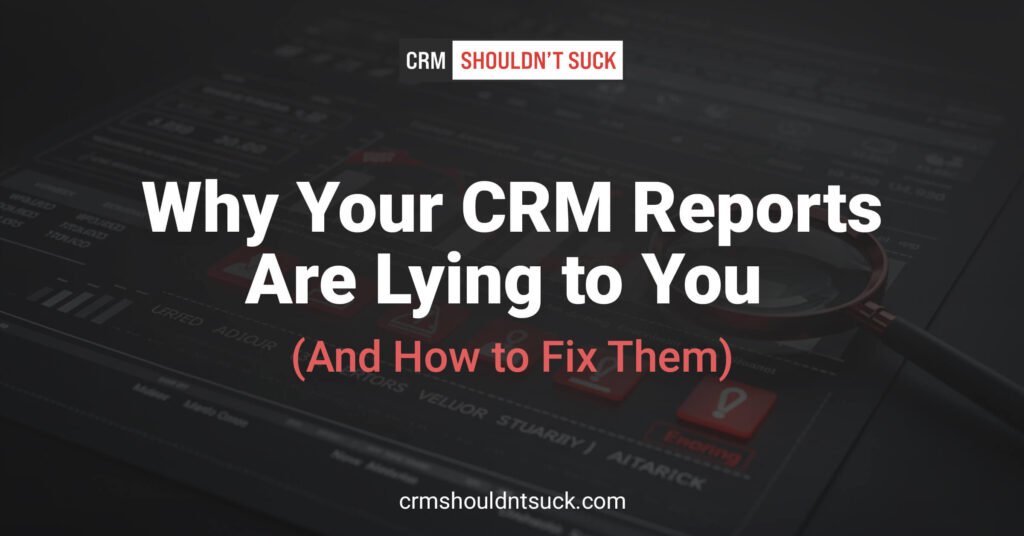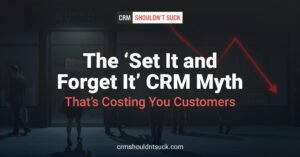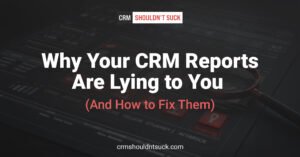The Illusion of Accurate Data
Every sales leader has experienced it: a meeting where the team reviews CRM reports filled with impressive numbers, only to realize later that they don’t align with reality. The pipeline looks healthy, but revenue targets are still being missed. Forecasts promise growth, yet deals that seemed locked in vanish without explanation. The disconnect between what the CRM reports say and what is actually happening in the business is not just frustrating—it is dangerous.
The problem isn’t the CRM itself. It’s the way the data is structured, entered, and interpreted. CRM reports can create an illusion of accuracy while hiding fundamental issues that keep teams from making informed decisions. Understanding why your CRM reports are misleading is the first step to fixing them.
The Data Integrity Crisis
Bad data is the silent killer of CRM effectiveness. If your sales team is not consistently updating opportunities, logging interactions, or maintaining accurate contact details, the reports generated will be riddled with inaccuracies. Dirty data results in inflated forecasts, unreliable conversion rates, and misaligned sales strategies.
One of the most common culprits is outdated or duplicate records. A deal that was marked as “likely to close” two months ago may still be sitting in the pipeline, creating an illusion of progress when in reality, it has stalled. Sales reps, often under pressure to meet activity quotas, may enter incomplete or inconsistent data just to check a box. Over time, these inaccuracies snowball, rendering CRM reports effectively useless.
The Reporting Black Hole
Sales teams and leadership often rely on pre-built CRM reports, assuming they provide a clear snapshot of performance. The issue is that many standard reports lack the nuance required to tell the full story. They capture surface-level metrics but fail to uncover the patterns behind them.
Consider a forecast report that shows a high volume of deals in later pipeline stages. On the surface, this suggests strong momentum. However, without analyzing the average deal velocity, sales cycle length, or the quality of opportunities, leadership may be basing decisions on flawed assumptions. If deals are stuck in later stages for longer than expected, it signals a blockage rather than growth.
Customization is key. CRM reports should be configured to surface actionable insights rather than just raw data. Instead of a generic “pipeline report,” sales leaders need reports that analyze trends in deal progression, identify bottlenecks, and highlight opportunities for coaching and intervention.
Over-Reliance on Vanity Metrics
Another major issue is the emphasis on vanity metrics over meaningful data. It’s easy to be impressed by high activity numbers—thousands of calls made, hundreds of emails sent, dozens of meetings booked. But activity alone does not equal revenue.
A CRM should track the effectiveness of these activities, not just their volume. How many calls resulted in meaningful conversations? How many emails converted into scheduled meetings? How many meetings turned into closed deals? Without measuring the impact of these actions, sales leaders are left guessing about what truly drives success.
The same principle applies to pipeline size. A bloated pipeline filled with unqualified deals only serves to give a false sense of security. Instead of tracking the sheer number of deals, sales teams should focus on pipeline health metrics such as the percentage of deals progressing from one stage to the next, the average deal size compared to past trends, and the probability of closure based on historical data.
Actionable Steps to Fix Your CRM Reports
Addressing these issues requires a strategic overhaul of how CRM data is collected, analyzed, and reported. Here’s how to turn misleading reports into reliable insights:
- Clean Your Data: Regularly audit and cleanse your CRM database to remove outdated, duplicate, or irrelevant entries. Establish clear data entry standards to ensure consistency.
- Customize Reports for Insight: Move beyond default CRM dashboards and create tailored reports that focus on deal velocity, sales cycle trends, and conversion rates.
- Tie Activity to Outcomes: Shift the focus from raw activity numbers to impact-driven metrics. Identify which actions correlate with revenue generation and optimize for those.
- Improve Forecasting Accuracy: Implement a rigorous deal review process to ensure sales reps are updating pipeline stages accurately. Require justification for high-probability deals and use historical trends to refine forecasting models.
- Encourage Sales Team Accountability: Train your team on the importance of accurate data entry and align incentives with maintaining high-quality CRM records.
A CRM is only as powerful as the data that feeds it. By identifying and correcting the flaws in your CRM reporting, sales leaders can turn misleading numbers into actionable insights that drive real growth. The key is not just having data but making sure that data tells the truth.



